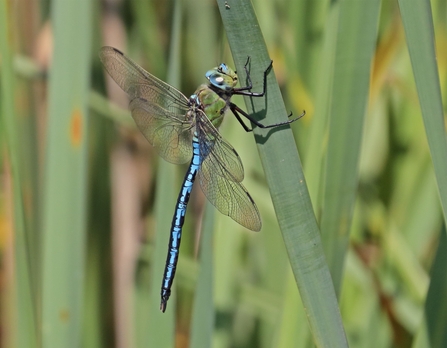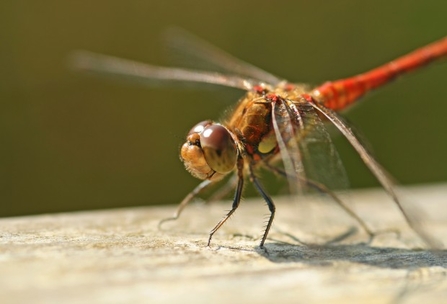July is the perfect month to spot dragonflies in their full glory. These fascinating insects, with their shimmering wings and agile flight, are a key part of our wetland ecosystems. Here are some species to look out for this month!
What to See in July
© Tim Hill

© Tim Hill
The large and colourful Emperor Dragonfly is around 7.8cm in length and is found by ponds, lakes, canals and flooded gravel pits (such as at Panshanger Park). The male is pale blue with an apple-green thorax and a black stripe down the length of his body. The female looks similar, but is a duller green-blue. The Emperor Dragonfly is one of the largest dragonfly species in Europe. Seen from June to August, it flies high in the air hunting its prey, which includes butterflies and other dragonflies. It catches and often eats these on the wing.
Brown Hawker laying eggs © Janet Packham
The Brown Hawker is another large dragonfly, at 7.3cm in length, and it has a chocolate-brown body with tiny yellow and blue markings, with golden-orange wings. It can be seen from June to September, patrolling or ‘hawking’ through woodland rides or over water. It particularly likes well-vegetated canals, marshes and reedbeds, but can also be seen at lakes and flooded gravel pits. It patrols a regular territory, which it defends aggressively against intruders.

© Tim Hill
The Broad-bodied Chaser is a medium-sized dragonfly at 3.9–4.8cm in length. It is also found by ponds and lakes, but sometimes along woodland edges. It can be identified by its broad body: the male’s a powdery-blue and the female’s a greeny-brown, but both with yellow spots down their sides. Once you’ve caught sight of this dragonfly, you’ll notice that it often returns to the same perch time and time again – great for taking photos!

Common Darter Male © Rachel Scopes
The Common Darter is 3.8–4.3cm in length, and can be seen throughout summer and autumn. The male is a striking bright red, while the female and immature adults are both golden-brown. It can be seen hovering above all kinds of waterbodies, and will dart forward suddenly to catch its prey. It will then take this back to a favourite perch to consume.
© Charlotte Hussey
Great reserves to see dragonflies include King’s Meads, where over 18 species of dragonfly have been recorded (including the rare Norfolk Hawker), Amwell (home to 21 species of dragonflies and damselflies), Hilfield Park Reservoir (large groups of Migrant Hawker dragonflies can be seen feeding over the water from July to the late autumn) and Stocker’s Lake, as well as Fir and Pond Woods (where 16 species, such as the Brown Hawker and Emperor dragonfly, have been seen).
And last but not least, Panshanger Park is home to 19 species of dragonfly and damselfly. In 2023, the British Dragonfly Society recognised the park as an official Dragonfly Hotspot. July (and the rest of summer!) is the perfect time to visit the park’s Dragonfly Trail to see how many you can spot!
You can also join us on Saturday 20th July for a Dragonfly Walk at Panshanger Park! Book your place here. There will be another on Saturday 17th August 2024 too, which you can book here.

